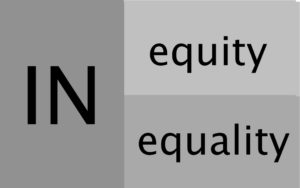RESOURCES
Big Idea: Inequity/Inequality
 On September 25th, 2015, a set of goals to end poverty, protect the planet and ensure prosperity for all were released by the United Nations. The 17 goals provide a series of concrete ideas and challenges to “end poverty, protect the planet and ensure prosperity for all”. At the heart of all of the goals and explicit in some are the concepts of equity and equality. In a world with a rapidly expanding population, finite resources, and vast disparities, how do we work towards greater equity/equality so that all can survive and thrive? Equity and Equality are fertile Big Ideas because they have to be looked at through multiple lenses and across academic disciplines to be fully understood. These Big Ideas also are perfect for developing important challenges at a local or global level.
On September 25th, 2015, a set of goals to end poverty, protect the planet and ensure prosperity for all were released by the United Nations. The 17 goals provide a series of concrete ideas and challenges to “end poverty, protect the planet and ensure prosperity for all”. At the heart of all of the goals and explicit in some are the concepts of equity and equality. In a world with a rapidly expanding population, finite resources, and vast disparities, how do we work towards greater equity/equality so that all can survive and thrive? Equity and Equality are fertile Big Ideas because they have to be looked at through multiple lenses and across academic disciplines to be fully understood. These Big Ideas also are perfect for developing important challenges at a local or global level.
To help you get started, we have created a sample challenge along with a set of learning objectives, Guiding Questions, Activities, and Resources. Remember that challenges need to be meaningful to the learners and their community and need to be designed to allow for solutions that are actionable. The challenges and the resulting solutions will be different based on the age and context of the learners. Finally, remember that the goal of a Challenge is both process and product – work with your learners to identify the goals and objectives to be addressed during the Challenge experience.
Big Idea: Equity and Equality (Inequity or Inequality)*
*The conversation around selecting one of these terms as a Big Idea will be a rich one. Equity and Equality have specific meanings and while related are not interchangeable.
Sample Challenges: Increase equity(Equality) or reduce inequity (Inequality)
Sample Learning Objectives:
The learners will be able to:
- differentiate between equity, inequity, equality, inequality, fairness, and unfairness
- explain the importance of these ideas in relation to the United Nations Sustainable Development Goals
- Explore issues through the lenses of equity, inequity, equality, inequality, fairness, and unfairness before forming opinions or making decisions.
- Identify, learn about, and act on opportunities to increase equity or reduce inequities in their local community or the world.
- Work collaboratively and demonstrate empathy
- Explain the different meanings and make connections between the use of equity, inequity, equality, and inequality, in different content/subject areas.
- Identify and explain the impact of equity, inequity, equality, inequality, fairness, and unfairness on specific populations historically and currently.
Sample Guiding Questions:
- What is equity, equality, inequity, and inequality?
- Why is equity important?
- Is equity possible?
- Is equality possible
- What is the difference between equity and equality?
- How is equity interpreted in different contexts?
- What is the relationship between equity and inequity?
- What is the role of history when considering equity?
- What is the role of geography and resources when exploring equity?
- What role does race, ethnicity and religion play in the equity conversation?
- How does equity look?
- How does inequity look?
- How do I experience equity? Inequity?
- What role does empathy play in equity?
- How do different subject areas look at equity and equality?
- What is the relationship between fairness, equity, and equality?
Sample Guiding Activities and Resources
- Explore and compare the definitions of equity, inequity, equality, inequality, fairness, and unfairness
- Search for and study various timelines concerning equity and equality (e.g., http://civilrights.findlaw.com/civil-rights-overview/civil-rights-timeline-of-events.html, https://www.cfr.org/blog/global-progress-toward-gender-equality-timeline.
- Review the United Nations Sustainable Development Goals for how the address equity and equality and the issues of concern.
- Have learners write, tell, or illustrate stories about experiences with equity and inequity, help them to distinguish between equality and inequality
- Analyze school rules, policies and procedures and determine if they are based on equity, equality or fairness.
- Compare how equity and equality are presented in all subject areas.
- Search for and visit local organizations focused on equity and equality and learn about their activities.
- Organize a debate on equity and equality.
